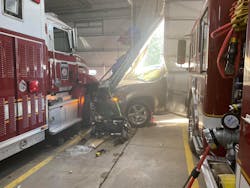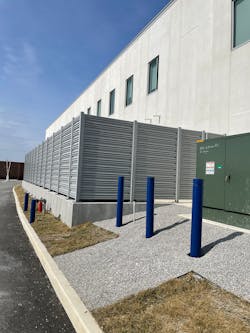Station Design: Protective Design and Physical Security Solutions
On May 26, 2022, I had the honor of speaking at the Station Design Conference. My presentation was on the use of protective design elements, such as fences, barriers and bollards, to provide a safe and secure environment at firehouses. It’s important to recognize the value of these products and to encourage their use to prevent vehicular incursions, acts of violence and other threats to public safety facilities.
Unfortunately, these incidents aren’t slowing. For example, in September 2022, a driver who experienced a medical emergency while behind the wheel crashed his vehicle into one of the stations of the Shawnee, KS, Fire Department. No firefighters were injured, but the station was damaged, of course, and a newer $1 million ladder truck was smashed to an extent that it had to be put temporarily out of service.
The driver, the firefighters, the equipment and the building all needed protection. Often, we are reactive to terrible things that happened. The fire service must start to take proactive initiatives.
Protective systems
The Storefront Safety Council, which is a nonprofit group that tracks vehicle-into-building crashes, reports that there are at least 100 collisions into a building every day in the United States. Three percent of those are crashes into government buildings. (The statistic doesn’t consider threats of violence or vandalism.) According to FEMA, 27,178 fire departments operate out of at least 52,001 fire stations. The odds are that at some point on the day that you read this column, a vehicle will crash into a firehouse.
Protective design must be part of the larger plan for fire stations. Typical physical protective systems do very specialized functions on project sites.
Fencing provides delineation, security, privacy and, in extreme cases, vehicular, bullet and/or blast resistance. A single fence line at a facility can serve at least 25 layers of security.
Gates afford access to those enclosures and allow secured egress and ingress for personnel and vehicles.
Bollards and other barriers provide a definitive point of prevention of vehicular incursion in vulnerable areas.Levels of protection
Three significant standards drive a lot of the decision-making in the product choices for protective design elements.
ASTM F2781: Standard Practice for Testing Forced Entry, Ballistic and Low Impact Resistance of Security Fence Systems defines how strong and resistant that a fence product is relative to a defined attacker, tool set and time frame. It also speaks to a measure of ballistic and vehicle resistance.
ASTM F2656: Standard Test Method for Crash Testing of Vehicle Security Barriers has become the premier standard for barrier systems that are used to protect critical infrastructure, data centers, government facilities and sports stadiums.
ASTM F3016: Standard Test Method for Surrogate Testing of Vehicle Impact Protective Devices at Low Speeds has become the more day-to-day solution that allows manufacturers to establish functional systems to address more unintentional or accidental vehicle incursions.
Using the products that are associated with the protection that conforms to these standards requires understanding of specifically what levels of protection that are expected of them. For example, these vehicle crash resistance standards range from the capability to stop a 2,500-lb. passenger vehicle to a 45,000-lb. semitrailer, each of which can be traveling at variant rates of speed and at variations of penetration distance using different dynamic-of-testing criteria. Although 90 percent of applications only require stopping a 5,000-lb. vehicle that’s traveling at 30 mph, a station’s specific circumstances and vulnerabilities might differ. Every site is unique, and you must look at each site on its own to ensure that the elements of protection that are incorporated into the design are used effectively.
Improper specification
How everything that’s around the firehouse affects its use is critical for decision-makers to comprehend. Parking, dispatch, recreational areas, apparatus bay egress and ingress, and adjacent businesses all must work in harmony. Using Crime Prevention Through Environmental Design (CPTED) and similar concepts and incorporating the latest innovations add to the success of the plan.
The most common mistake that’s made is choosing a product that doesn’t properly address a facility’s unique needs. Someone who misunderstands the requirements or sees a flashy new product can end up spending money on a product that doesn’t wholly serve the needs of the station.
Why spend money for a 10-foot fence when an 8-foot fence might suit the needs better? Why buy a bollard system to stop a stake truck when the most viable threat is a pickup? Totally surrounding the site of a firehouse with a bollard array typically isn’t the best answer to helping to avoid vehicle incursions, but placing some arrays in strategic locations will help to mitigate issues for sure. Strategic locations can include the main entry to the building and the exposures where vehicle crashes are most likely to occur.
Similar consideration must be made with the fence and gates.
Qualified expertise
Physical security products have seen more change in the past five years than in the 30 years prior. Evolving standards, a plethora of new manufacturers and changing needs have made decisions regarding those products more challenging.
Fire chiefs and city managers who are looking to protect their facilities may choose a consultant to help to guide them in the decision-making process. Vetting those partners is critical to success. Find those who have the security credentials.
Organizations, such as American Society for Industrial Security, offer board certification. Physical Security Professional (PSP) and Certified Protection Professional (CPP) are the gold standards for security management professionals. Other affiliations, such as Security Industry Association (SIA) or the US CPTED Association, offer added perspective. (Editor’s note: For full disclosure, the author is PSP-certified and a member of SIA.)
As important, find people who have experience in firehouse, police and local government facilities and who can prove previous commitment to tight budgets, restrictive needs and the politics that surround those decisions. If the consultant immediately takes you to the high end of the product spectrum—to install products to stop a Mack truck or to resist a SEAL team, for example—a red flag should go up.
Find someone who understands that a firehouse is just that, a house, a working “family” that interacts with the community. Such an advocate will help to navigate the realm of physical protective systems while considering the real-life implications.
Follow-through
Planning and preparedness don’t end with the plans and specifications. Inspect the project during construction to verify proper installation and compliance with standards. Don’t allow fences, gates, bollards and so forth to be installed “close enough.” Proactive initiatives can’t risk even the slightest failure or vulnerability.
Fire chiefs and city managers must start to plan for physical security measures before terrible things happen, whether intentional or unintentional—not after a breach, after a vehicle hits the station or after a member’s life is lost.

Robert Miller
Robert Miller is a perimeter security consultant who has more than 35 years of experience. He has been hands-on in the office and in the field, which provides him with the ability to professionally guide those who want to secure their perimeter by assessing the vulnerability of their site and determining the correct products and design layout that are relative to their needs. Miller is committed to lifelong learning to ensure that the latest trends and standards of the industry are utilized to ensure a complete and effective perimeter security solution. He can be reached at [email protected].







